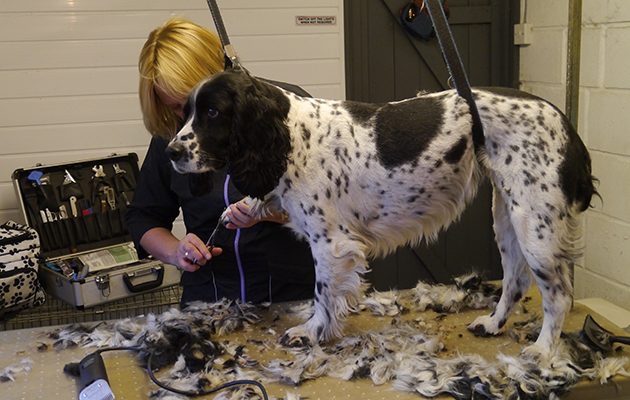Working dogs tend to be low maintenance but regular grooming will help prevent problems, says David Tomlinson - and your gundog will enjoy it
If your working dog has never seen a brush, it is far from alone. But regular gundog grooming will help prevent problems whatever the breed, says David Tomlinson, and they will enjoy it, too.
Does an at-home grooming attempt beckon? Whether you have a labrador only in need of a quick brush or a spaniel that requires more attention, follow our advice and read gundog grooming – top tips and techniques.
GUNDOG GROOMING
Many years ago I borrowed a foxhound bitch from my local pack and entered her in the village dog show, a surprisingly popular affair that had drawn entries from considerable distances. We took part in the hound class, and found ourselves in the ring behind an elegant woman with a beautifully groomed Afghan hound bitch.
“Does she require a lot of grooming?” I asked, somewhat feebly, as the answer was obvious.
Until then, the foxhound and I hadn’t received so much as glance, but I did get my answer. “About an hour a day.”
I was relieved that I wasn’t asked how much time I spent grooming my hound, as I doubt if she had been brushed in her life.
It was a reminder that some dogs are much higher maintenance than others. I suspect that most of us with sporting dogs rarely get the brush out; if we do, it’s because there are burrs in the spaniel’s ears or the Jack Russell has been down a rabbit hole. However, if you want to keep your dog healthy and happy, then devoting time to routine maintenance is sensible.
Labradors don’t generally need much brushing and I know quite a few that have never been groomed in their lives. However, a good weekly going over with a body brush, the sort you might use on a horse, is great for getting rid of dried mud and dust and distributing the oils through the fur. Labradors do shed, so brushing will help rid the coat of dead hair and keep your dog looking glossy. Most dogs enjoy being brushed, especially if they have been accustomed to it from puppyhood.
Other shorthaired breeds, such as German pointers, should be treated in the same way. However, for the longhaired breeds, a group in which I would lump everything from golden retrievers to springer spaniels, more regular grooming is essential. Regular brushing will considerably reduce the amount of hair that is shed in the house or car, or over your clothes. With spaniels it’s essential to keep the feathers on their ears and legs well groomed to stop them becoming knotted. A more radical solution is to have the dog clipped out regularly. My springer goes to the groomer every three months for a short back and sides, and comes back looking like a pointer puppy. Such drastic treatment isn’t recommended in any of my spaniel books, but my groomer tells me that she is now seeing a growing number of spaniels, both springers and cockers, for similar treatment.
PROFESSIONAL VS DIY
If you are skilled with the clippers you can strip your own dog. I’m not, so it’s much more cost effective to use a professional. I once snipped into one of my spaniel’s ears when trimming her feathers. Though it appeared to be only a very small cut there was blood everywhere, leading to an expensive visit to the vet for a couple of stitches. I did learn my lesson.
Roadwork will help keep your dog’s nails short, otherwise these will need regular trimming. This is easy to do yourself as long as you have proper canine nail clippers –human clippers aren’t up the job. Most groomers will also do this for you and charge a lot less than the vet. Groomers will usually offer the option of bathing your dog after it has been groomed. This is an option I don’t bother with, as my dogs only get bathed when they have been rolling in something smelly.
One of my major dislikes is smelly doggy breath. This is easily avoided if the dog gets a proper diet with plenty of bones to chew, but those animals that eat nothing but soft food out of a packet invariably suffer from plaque and smelly breath. There are plenty of commercial chews available that are claimed to keep teeth and gums healthy and they are worth using, but regular brushing of a dog’s teeth, using toothpaste, makes sense. I use a human toothbrush together with poultry-flavoured canine toothpaste. The latter is expensive compared with the human variety, which should never be used as it contains fluoride that is poisonous to dogs. My dogs are always happy to have their teeth cleaned, making me feel guilty that I rarely remember to do it more often then once a week. A gamekeeper friend has just acquired an electric toothbrush for her dogs: I’m looking forward to hearing how she gets on with it.
Just as your nose will tell you if your dog has a problem in its mouth, it’s also a useful tool for checking the health of its ears. A quick sniff will inform you instantly if there’s something wrong, and if you are a spaniel owner in particular it’s a sensible habit to get into. Dogs shouldn’t really have pendulous ears, it’s a basic design fault, but it’s one that many gundogs are born with so it is up to us owners to make sure we keep them clean and free from infection.
Looking after your dog properly requires lots of handling, so it pays to get puppies used to being inspected all over. And don’t forget that however healthy your dog seems to be, an annual health check at the vet’s always makes sense.





